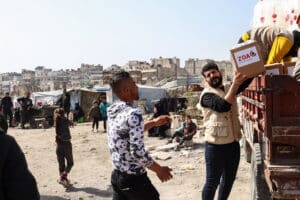On February 6th, an Earthquake of 7.7 magnitude hit Gaziantep with tremors felt across the Syrian Arab Republic. Thousands of buildings have been damaged, affecting 8.8 million Syrians. The Dutch Relief Alliance partners used the already ongoing Protracted Joint Response to coordinate and address some of the most immediate needs of the affected population. An Acute Joint Response was added to scale up the response activities in the most severely affected locations. Recently the Joint Response lead Marleen Spieker from ZOA sat down with partner organizations in Syria to discuss the situation as it is developing.
“We are back to zero.”
The partner organisations Spieker talked to were amongst the first to respond and have seen the situation evolving. The organisations have been working in the area of Aleppo, Idlib, and Lake Governorates. They recount the difference between before and after the earthquake: “Before the earthquake, we were moving away from relief aid and started really focusing on the development stage of the humanitarian assistance. We were building schools, hospitals, investing in training programmes and agricultural production”. However, since the earthquake, the partner organisations have had to “go back to zero”. Humanitarian assistance has gone back to being about providing basic needs such as food, shelter, and water. This natural disaster has wiped away all the progress achieved on a development level. One of the partners mentions how it will “take a long time before we return to where we were before the earthquake”.

Housing remains the most pressing issue.
The rollout of delivering essential humanitarian assistance has been successful, with around 40’000 people getting food and livelihood support with distribution still ongoing. However, as the earthquake’s immediate aftermath settles down, and even as the situation is constantly evolving, one of the critical problems becoming apparent is long-term shelter and proper housing for people who lost or have unsafe homes. As one of the partners puts it: “people cannot make lives in shelters”, therefore, “emergency housing is not a long-term solution”. The emergency shelters, for instance in schools, struggle with overcrowding and lack of privacy. In Aleppo over 700 people are in one school, with 300 people sharing two bathrooms. The harsh reality of emergency shelters has made people more willing to return to their homes even though they have not been evaluated as secure. The partners emphasised that finding permanent housing for people remains crucial and should be done either: “through evaluating damaged houses and making sure they are safe for people to return or renting out new houses for people”.
Looking towards the future
Syria has approved the continued use by the United Nations of two additional border crossings to deliver aid into Syria for the next three months. Nevertheless, Syria is at risk of succumbing to another earthquake in the coming years. Therefore, it is essential to set up certain systems that can quickly be triggered in the case of another earthquake. Spieker states that we could ensure better emergency preparedness by investing in the resilience of communities to cope with shocks. Additionally, in the case of natural disasters, partners stressed how volunteers and humanitarians are also directly or indirectly affected, potentially hindering their capacities. In the future a support system should be put in place that supports humanitarians so that they, in turn, can provide effective and timely relief in the affected area.
Image credit: Lieuwe Siebe de Jong (ZOA)
Save the Children
Laan van Nieuw Oost-Indië 131-k
2593 BM Den Haag
The Netherlands
Chair organisation: Plan International
E: office@dutchrelief.org